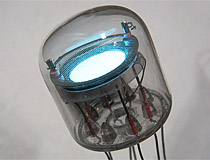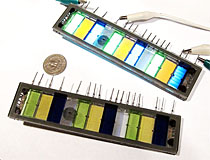
 |
| Vacuum Fluorescent Displays |
Vacuum fluorescent display tubes share more in common with a cathode ray tube than they do with the Nixie tubes they tend to mimic. A VFD tube has a low voltage filament which is energized in a vacuum, causing electrons to 'boil' off. Metal plates covered with a phosphor coating are charged to between 25 and 50 volts, causing electrons leaving the filament to strike the plates and illuminate the phosphor. Later models of VFD also have a control grid, a metal screen that is placed between the digit and the filament. The control grid acts as a valve, allowing the digit to be turned on or off without the need to power down and re-heat the filament. |
|
| General Electric Y1938 | |
Devices included in this entry: General Electric Y1938 Datasheet (PDF, 136kb) |  |
| Tung-Sol DT-1704C 'Digivac' | |
The DT-1704C, produced by Tung-Sol, is one of the earliest and most primitive VFDs known. The tube consist of a series of phosphor targets mounted on a mica frame and packaged in a narrow 9 pin envelope. Like other early VFD tubes, this device predates the inclusion of a control grid and therefore can not be multiplexed. The DT-1704C seems to be very failure prone; bent heater filaments and uneven or partially unlit segments are common. The pinouts of this tube are identical to the General Electric Y-1938 display shown here. |  |
| Soviet IV-29 VFD Tube | |
The IV-29 is an uncommon Russian-made single dot indicator, built around VFD hot cathode technology. Much like the neon filled IN-28, the IV-29 is designed to be used as a single pixel in large segmented and bitmapped displays. This tube has a diameter of 29mmm and is quite large for a pixel indicator; the IN-28 and IV-29 actually use identical diameter glass envelopes in their construction, allowing the two tubes to be intermixed to make multicolor displays. The tube's flying lead base is designed to be directly soldered into the target device; the mind recoils at the thought of replacing burned out bulbs in a large matrix display constructed of these. |  |
| Soviet Reflector ILM2-9MV 'Jumbotron' VFD Display | |
The ILM2-9MV is a large Russian three color VFD intended for use in the construction of 'jumbotron' style full color displays. This tube consists of three pixels, each constructed out of three colored bars. For either cost or availability reasons, a pale green phosphor is used for both the blue and green color bands; a colored lacquer is applied to the outside of the tube over the blue and green sections to create a three color device. The tube's rear mounted nipple has been offset so that it does not coincide with one of the display pixels. The VFD-based technology in this tube is dimmer than that in Futaba's competing CRT-based products like the TL-3508XA, but it is much easier to drive with solid state technology. The ILM2-9MV is a recent tube by Russian standards, these examples were made by Reflector in the mid-1990's for the export market. |  |
| ©2000-2025 Industrial Alchemy. All rights reserved. | Switch to mobile version | Contact | |  |